
The Solar-Terrestrial Centre of Excellence (STCE) is a collaborative network of the Belgian Institute for Space Aeronomy, the Royal Observatory of Belgium and the Royal Meteorological Institute of Belgium.
 |
Published by the STCE - this issue : 19 Jun 2015. The Solar-Terrestrial Centre of Excellence (STCE) is a collaborative network of the Belgian Institute for Space Aeronomy, the Royal Observatory of Belgium and the Royal Meteorological Institute of Belgium. |
| Archive of the newsletters | Subscribe to this newsletter by mail |
The STCE Annual meeting 2015 took place on 11 June. After a brief introduction by Ronald, a fully packed Meridian room first enjoyed a presentation on SOLSPEC by David Bolsée after which Simon Chabrillat gave a summary on the workshop "Natural Hazards assessment for Aviation" (see the Newsletter at http://www.stce.be/newsletter/pdf/2015/STCEnews20150605.pdf).
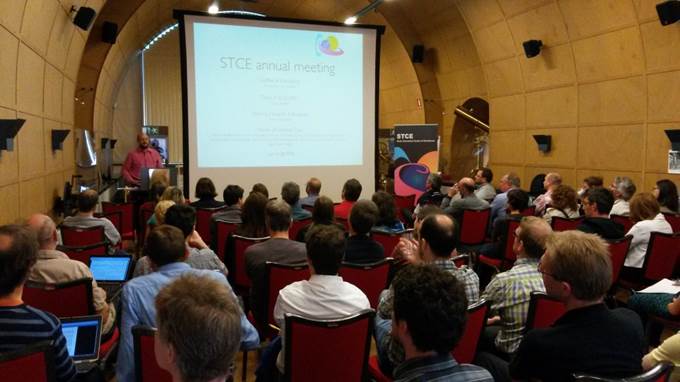
Then started the main part of the meeting, i.e. the visit of various important but not-so-well-known labs and tools which are spread all over the Space Pole. For this "Points-of-Interest" tour, the participants were split into small groups of about 5 persons. Each group was accompanied by a guide who knew his/her way around the Pole. The visit of each point took only 10 minutes or less, making this a quite dynamical and very interactive walk.
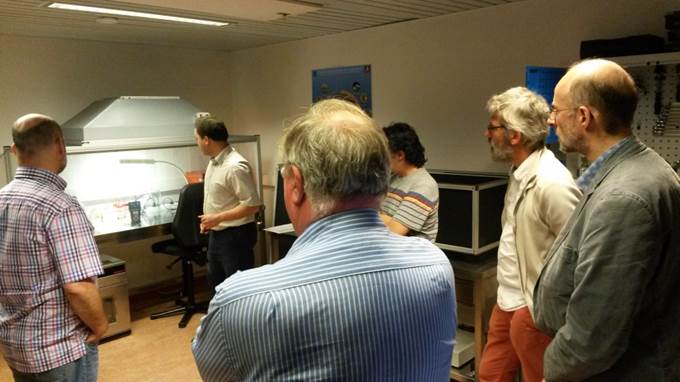
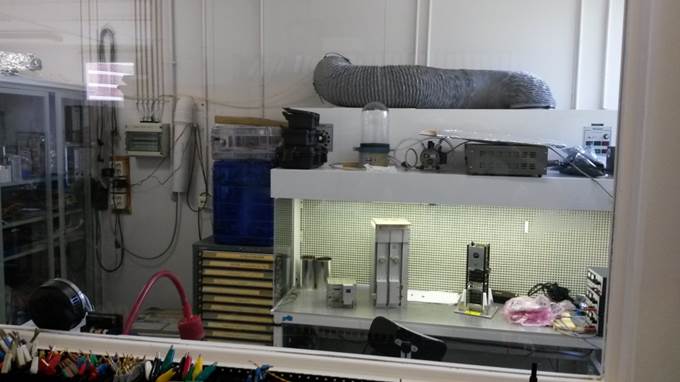
Visits included the high-tech Detector Lab (Samuel Gissot and Boris Giordanengo), the SDO Data center (Koen Stegen) which handles 1.5 Terabytes (!) per day, and the meteo measurements and satellite techniques lab showing amongst other the cubesats (Andre Chevalier and Christian Conscience) - Images above.
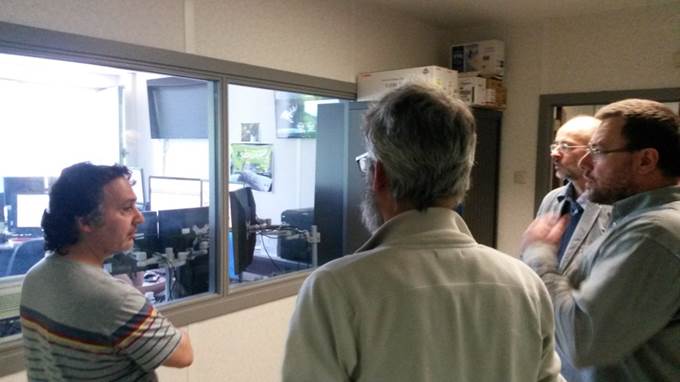
The visit to the Electronics Lab and Engineering Realisations (Eddy Neefs and Sophie Berkenbosch) gave the participants a good idea on the fine art of soldering. Michel Kruglanski showed the very operational nerve centre B.USOC (Belgian User Support and Operations Centre), and provided a practical example with the FSL (Fluid Science Laboratory) which is aboard the ISS but controlled and operated from the B.USOC.
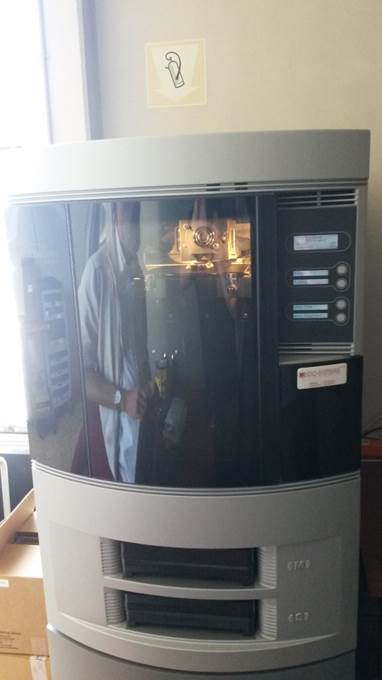
The tour continued with a visit of the very Clean Room (Eddy Equeter), and participants also enjoyed an impressive performance of the 3D printer and machinery (Jeroen Maes).
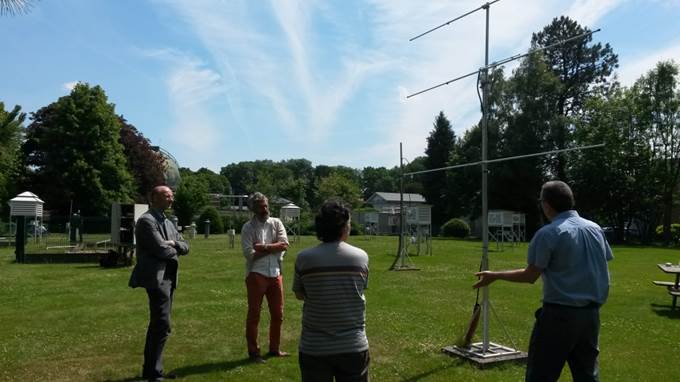
There was also a tour stop at the big meteor antenna (Hervé Lamy) in the meteo park, as well as at the Solar Mechanics and Electronics lab and the Solar Dome (Jean-Luc Dufond, Aydin Ergen and Ghislain Rigo). The sunny weather provided also an opportunity for sunspot observing.
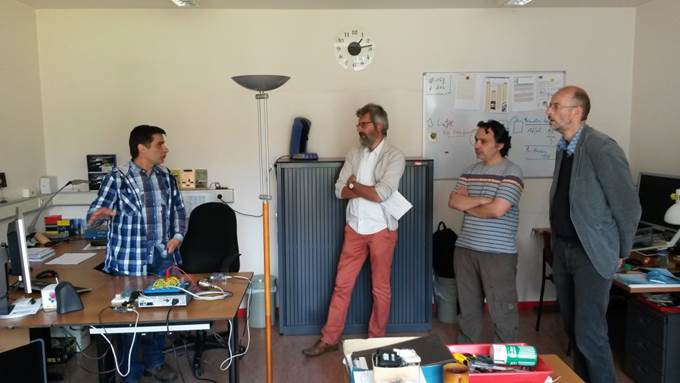
One more point-of-interest remained, and that was the canteen of the RMI where food and refreshments were served and much appreciated. It concluded a great edition of the STCE Annual meeting.
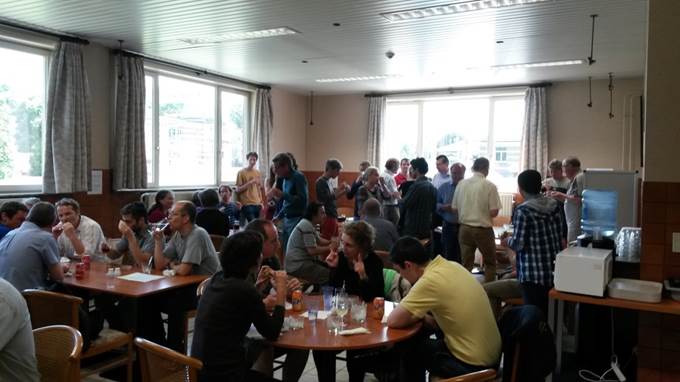
Solar flare activity fluctuated between very low and moderate during the week.
In order to view the activity of this week in more detail, we suggest to go to the following website from which all the daily (normal and difference) movies can be accessed:http://proba2.oma.be/ssa
This page also lists the recorded flaring events.
A weekly overview movie can be found here (SWAP week 272).
http://proba2.oma.be/swap/data/mpg/movies/weekly_movies/weekly_movie_2015_06_08.mp4
Details about some of this week’s events, can be found further below.
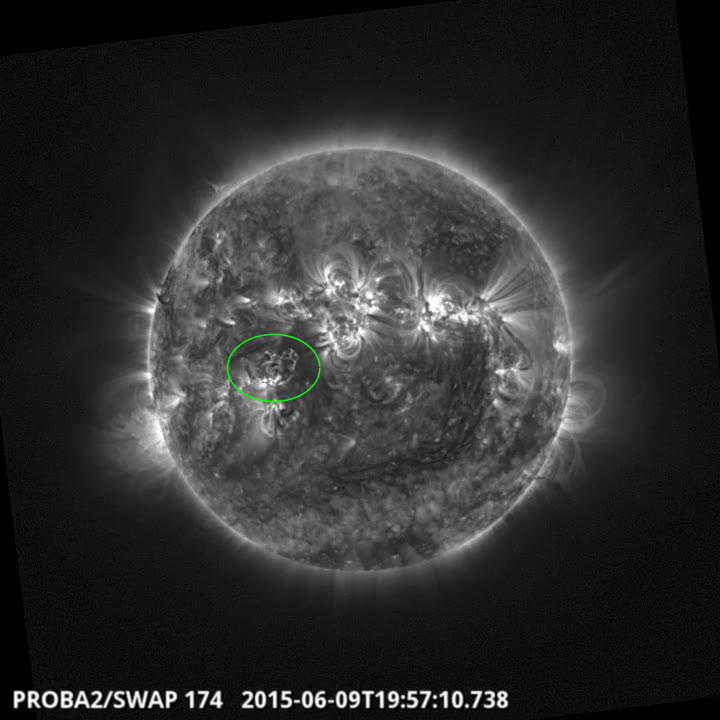
C-Flare on the east half @ 19:57 SWAP image
Find a movie of the event here (SWAP movie)
http://proba2.oma.be/swap/data/mpg/movies/20150609_swap_movie.mp4
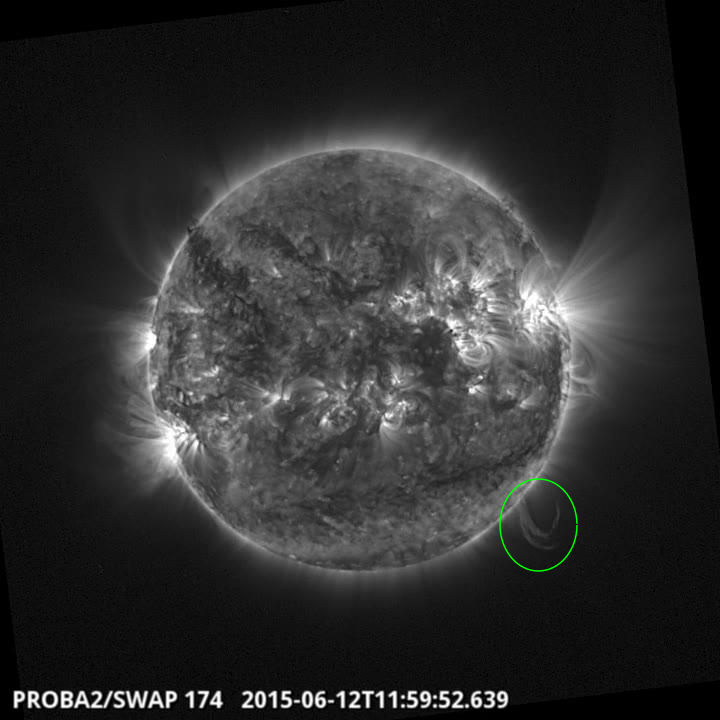
Plasma dynamics on the west limb @ 11:59 SWAP image
Find a movie of the event here (SWAP movie)
http://proba2.oma.be/swap/data/mpg/movies/20150612_swap_movie.mp4
Solar activity was low to moderate with fifty-nine C- and three M-class flares occurring during the past week. NOAA regions 2360 and 2367 were the regions with the largest contribution, while a few flares were produced by NOAA 2361, 2364, 2365 and 2366. The strongest flare was a M2.0 flare on June 14.
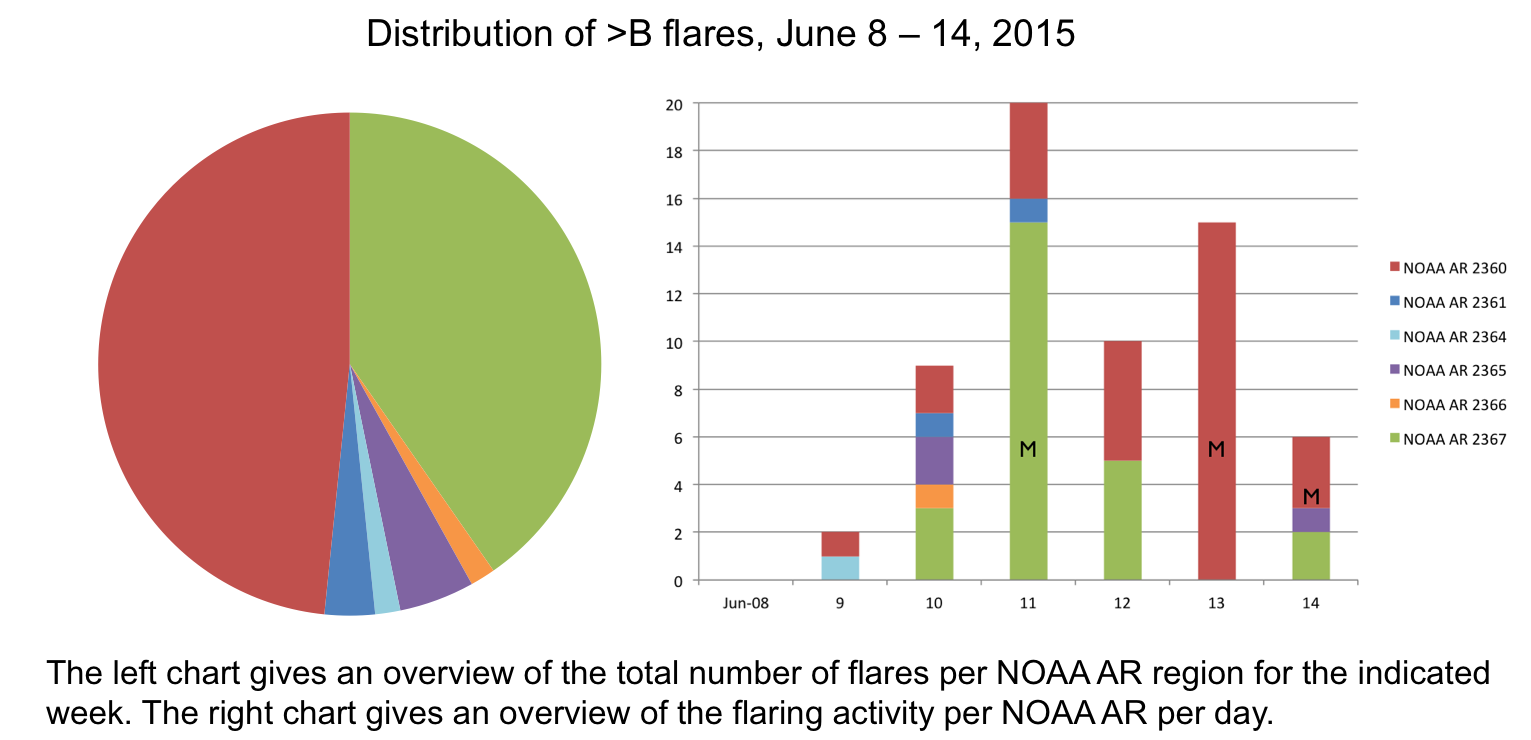
One partial halo CME was observed, with first measurement in LASCO/C2 at 20:24 UT on June 9. At the first analysis, it was perceived to be a frontside event. However, the position of the source region did not fully match. Even without any signature in STEREO images, the event was determined as back sided. The source region could not be assigned with complete certainty.
There were a few filament eruptions, e.g. on June 9 and 14 in the northeast quadrant, but without any strong geoeffective CMEs.
A small equatorial coronal hole crossed the central meridian on June 11. The associated solar wind flow arrived on June 14 (see Review of Geomagnetic Activity).
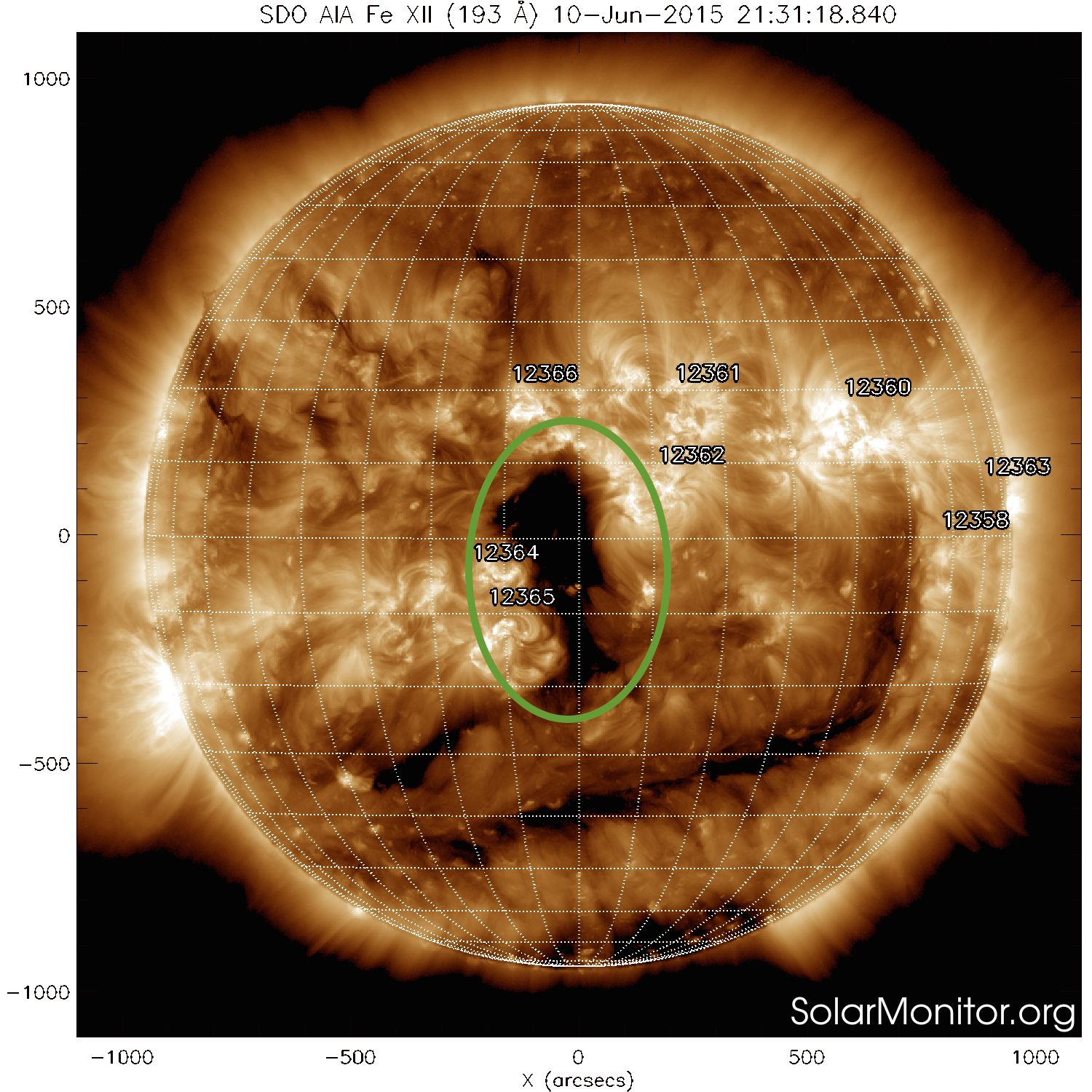
| DAY | BEGIN | MAX | END | LOC | XRAY | OP | 10CM | TYPE | Cat | NOAA |
| 11 | 0849 | 0855 | 0859 | M1.0 | 2367 | |||||
| 13 | 0720 | 0729 | 0747 | N11W78 | M1.3 | SF | 79 | 2360 | ||
| 14 | 0052 | 0059 | 0109 | N14W73 | M2.0 | SF | 79 | 2360 |
| LOC: approximate heliographic location | TYPE: radio burst type |
| XRAY: X-ray flare class | Cat: Catania sunspot group number |
| OP: optical flare class | NOAA: NOAA active region number |
| 10CM: peak 10 cm radio flux |
In the beginning of the week the solar wind was under influence of a high speed stream emanating from a coronal hole that passed the central meridian on June 4. Solar wind speed increased to maximally 700 km/s and the magnitude of the interplanetary magnetic field (IMF) peaked at 23 nT with periods of a negative north-south component down to -21 nT. Solar wind speed gradually declined on June 11 and 12 and the magnitude of the IMF was near 5 nT till the arrival of a weak transient, at 12:30 UT on June 12. The magnitude of the IMF became more variable and went to 11 nT. Another high speed stream associated to the above mentioned equatorial coronal hole resulted on June 14 in a limited increase of the solar wind speed (to 620 km/s) and fluctuation of the IMF magnitude (to maximally 12 nT).
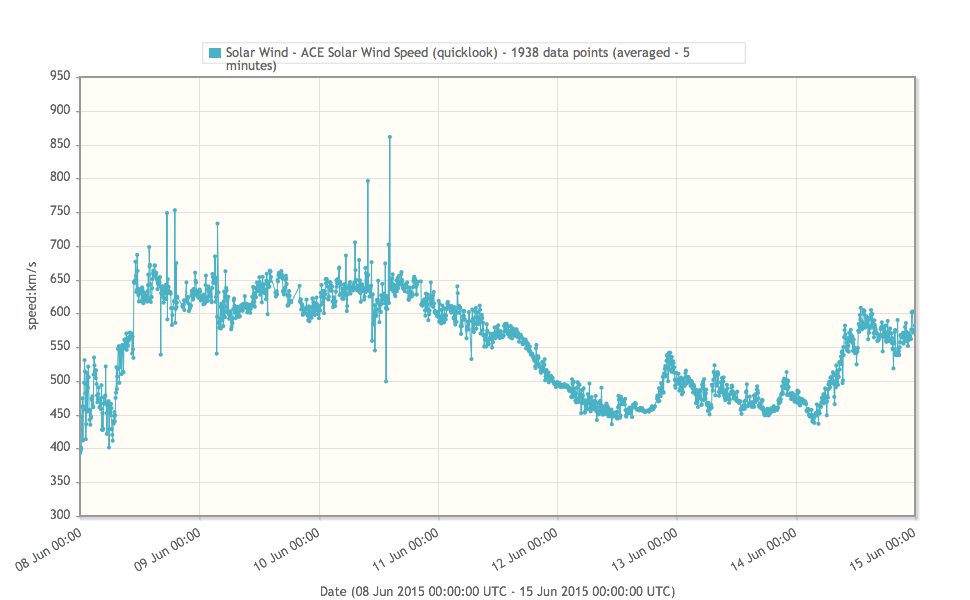
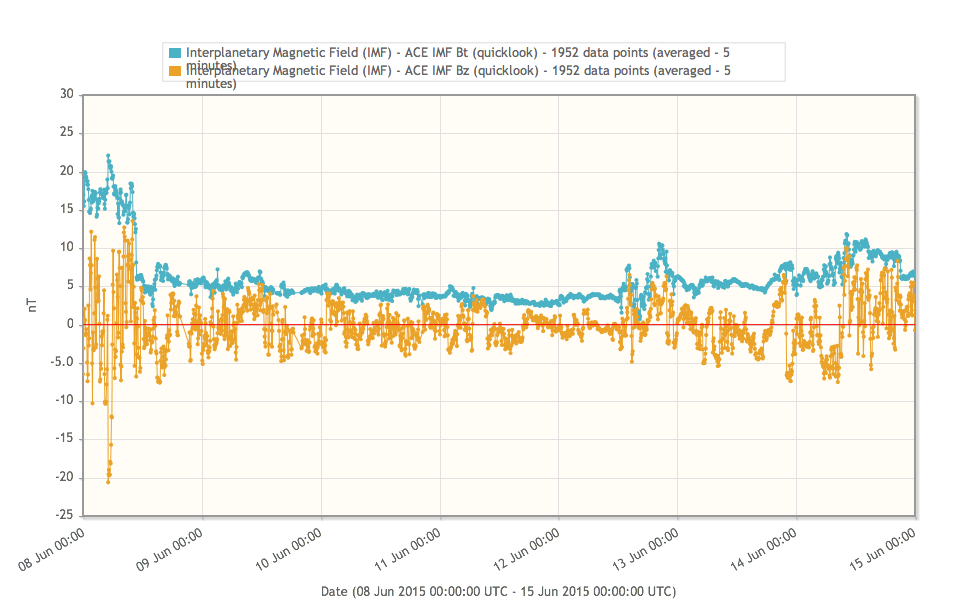
From June 9 to 13, geomagnetic conditions were quiet (K=1 to 2) to unsettled (K=3) with a few isolated slots of active (K=4) levels. Minor storm levels were reached on June 8 at the local level (Dourbes K=5) and even major storm levels at the planetary level (NOAA estimated Kp=6 from the slot 6-9 UT). The planetary index reached minor storm level for one time slot (9-12 UT) on June 14.
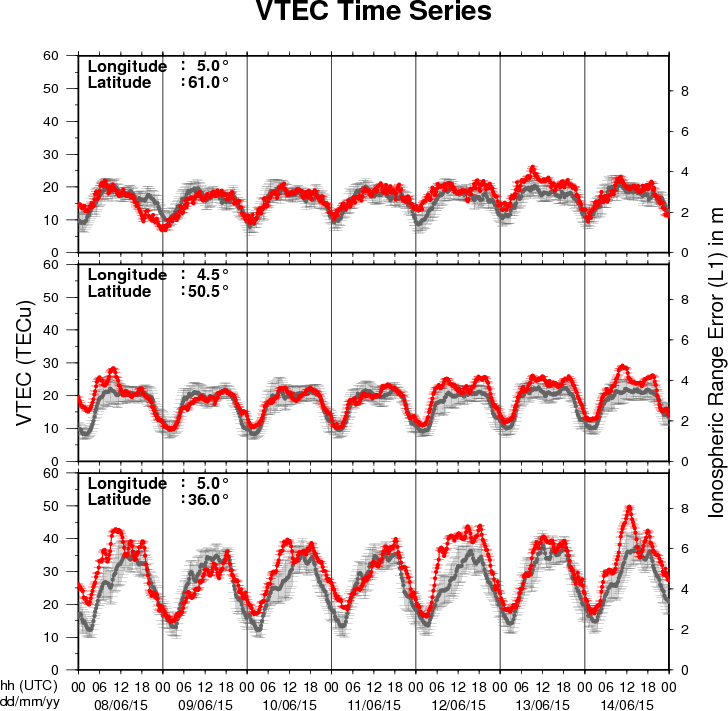
The figure shows the time evolution of the Vertical Total Electron Content (VTEC) (in red) during the last week at three locations:
a) in the northern part of Europe(N61°, 5°E)
b) above Brussels(N50.5°, 4.5°E)
c) in the southern part of Europe(N36°, 5°E)
This figure also shows (in grey) the normal ionospheric behaviour expected based on the median VTEC from the 15 previous days.
The VTEC is expressed in TECu (with TECu=10^16 electrons per square meter) and is directly related to the signal propagation delay due to the ionosphere (in figure: delay on GPS L1 frequency).
The Sun's radiation ionizes the Earth's upper atmosphere, the ionosphere, located from about 60km to 1000km above the Earth's surface.The ionization process in the ionosphere produces ions and free electrons. These electrons perturb the propagation of the GNSS (Global Navigation Satellite System) signals by inducing a so-called ionospheric delay.
See http://stce.be/newsletter/GNSS_final.pdf for some more explanations ; for detailed information, see http://gnss.be/ionosphere_tutorial.php
Start : 2015-07-05 - End : 2015-07-09
We would like to invite you to submit contributed abstracts to
the parallel session "The science of space weather: progressing our
understanding" at the 2015 UK National Astronomy Meeting from 5-9
July (http://nam2015.org). The abstract-submission deadline is 1
April 2015. Observers, modellers, and theoreticians are all
welcome. We also welcome participation from end users interested in
how the science of space weather is advancing.
The science of space weather: progressing our understanding
The goal of this session is to provide an opportunity to discuss
the scientific research that underpins space weather and how a new
generation of operational space weather measurements could best be
utilised to further progress our understanding. Specific topics are
likely to include 1) gaps in our understanding of space weather and
how to resolve them, 2) new space and ground-based data that are
needed, 3) new science that can be carried out with the operational
space weather measurements being planned today.
This session is motivated by the fact that the UK has a strong
heritage in the science of the coupled Sun-Earth system, from both
an observational and theoretical perspective. This research is
increasingly being applied to the area of space weather monitoring
and forecasting, a topic that is now nationally recognised as an
important natural hazard for the UK (highly ranked in the National
Risk Register) and the subsequent opening of the Met Office Space
Weather Operations Centre in 2014.
Up until now, both the research and the space weather monitoring
and forecasting have utilised mainly data from instrumentation
(both space- and ground-based) designed to answer pertinent
scientific questions, though some operational instruments (e.g. the
X-ray and particle detectors on NOAA's GOES spacecraft) are also
widely exploited for scientific use. However, there is now growing
interest in deploying more instruments, in space and on the ground,
designed to support operational space weather services. Such
operational measurements can facilitate new science, as
demonstrated by the extensive research use of GOES data, but it is
important that the limitations imposed by operational needs are
discussed.
Website: http://nam2015.org/
Start : 2015-07-13 - End : 2015-07-24
The CISM Summer School is intended to give students a
comprehensive immersion in the subject of space weather: what it
is, what it does, and what can be done about it. Space weather is
many things: beautiful when seen through the eyes of a sun-viewing
telescope, fascinating when studied for its alien worlds of
magnetic structures and phenomena, awesome when witnessed as a
solar eruption or auroral storm, and devastating to the users of
services it disrupts. Space weather links the Sun, the Earth, and
the space in between in a branching chain of consequences. Weather
systems on the Sun can spawn interplanetary storms of colossal size
and energy that envelop the whole planet in electrical hurricanes.
Such storms attack high-tech, complex, and expensive technological
systems that provide much of the infrastructure that allows modern
society to function.
Website:
https://www2.hao.ucar.edu/Events/2015-CISM-Summer-School
Start : 2015-07-21 - End : 2015-07-23
The conference will review past and recent achievements, as well
as future challenges in the field of solar coronal loop
physics.
Website:
http://www.damtp.cam.ac.uk/user/astro/cl7/index.html
Start : 2015-07-28 - End : 2015-08-04
Heliophysics is all of the science common to the field of the
Sun-Earth connections. This fast-developing field of research
covers many traditional sub-disciplines of space physics,
astrophysics, and climate studies. The NASA Living with a Star
program, with its focus on the basic science underlying all aspects
of space weather, acts as a catalyst to bring the many research
disciplines together to deepen our understanding of the system of
systems formed by the Sun-Earth connection.
Website:
http://www.heliophysics.ucar.edu/
Start : 2015-07-30 - End : 2015-08-06
The 34th International Cosmic Ray Conference (ICRC) will be held
from July 30 to August 6, 2015, in The Hague, The Netherlands. It
is an important and large conference in the field of Astroparticle
Physics. The ICRC covers: cosmic-ray physics, solar and
heliospheric physics, gamma-ray astronomy, neutrino astronomy, and
dark matter physics.
Website: http://icrc2015.nl
Start : 2015-08-31 - End : 2015-09-04
The purpose of this conference is to discuss the latest
questions and results in solar and stellar physics. Solar and
stellar seismology will be one particular focus but contributions
on all aspects of solar-stellar relations will be welcome. We aim
to establish links and synergies between the day- and night-time
fields of astrophysics.
Website:
http://www.iac.es/congreso/solarnet-3meeting/
Start : 2015-09-02 - End : 2015-09-04
The Workshop will address how the joint exploration of the
corona and inner heliosphere will lead to advances in our
understanding of coronal heating and solar wind acceleration, the
magnetic and plasma structure of the heliosphere, and the
acceleration of energetic particles at shocks and flares. The
workshop will inspire research that will make use of SO and SPP
observations within the context of the NASA Heliophysics
Observatory System and identify key areas for preparatory research.
Synergistic observations from other ground based and space based
assets will also be addressed.
Website:
http://www.solarprobeplus.org/2015/
Start : 2015-09-06 - End : 2015-09-13
The International Workshop and School on solar system plasma
turbulence, intermittency and multifractals (STORM 2015) focus on
the quantitative experimental, theoretical and numerical
investigation of turbulence, intermittency, fractal/multifractal
features, waves and coherent structures interaction, criticality
and non-linear cross-scale coupling. As widely documented by
in-situ satellite measurements and remote or ground-based
observations, turbulence, intermittency and dynamical complexity
are quite ubiquitous processes observed in the dynamics of solar,
planetary and interplanetary plasmas, as well as in the dynamical
evolution of proxies linked to magnetospheric and ionospheric
variability.
Unfolding the spatio-temporal structure of magnetic field and
plasma fluctuations from experimental observations and numerical
simulations provides further insight on the structure of plasma
turbulence and intermittency. On the theoretical side, the
understanding of such complex dynamical behavior cannot be simply
surmised from the basic fluid/kinetic equations, but instead
requires novel theoretical, experimental and data analysis
approaches. The workshop is a forum to present and discuss latest
results in these fields. The purpose of the school is to give to a
young audience of Graduate, Ph.D. students, and postdoc scientists,
which ideally represents the next generation of scholars in the
physics of space plasmas, an overall view of both theoretical and
data analysis tools apt to fully exploit unique and unprecedented
observations that will be provided by future upcoming mission like
Solar Orbiter and Solar Probe Plus.
Website:
http://www.spacescience.ro/conferences/storm2015/
Start : 2015-09-07 - End : 2015-09-11
The meeting will cover various aspects of solar physics and
space weather related processes. The special emphasis will be paid
to progress in data-driven simulations and high-resolution
spectro-polarimetry as powerful diagnostic techniques to unravel
information about magnetic fields in the photosphere and
chromosphere of the Sun.
Website:
http://ssg.group.shef.ac.uk/Conferences/Ukraine_UK_2015/index.html
Start : 2015-09-14 - End : 2015-09-18
This summer school will acquaint a generation of young
researchers (advanced master students, PhDs, and junior
postdoctoral researchers) to modern open-source software efforts
adapted to High Performance Computing platforms, with a deliberate
focus on hands-on sessions. In these sessions, participants will
work with three different open-source software packages, learn
about their typical applications and evaluate their performance
aspects on massively parallel systems.
Website:
http://www.fz-juelich.de/ias/jsc/EN/Expertise/Workshops/Conferences/CSAM-2015/_node.html
Start : 2015-09-14 - End : 2015-09-18
Hinode is a solar satellite funded jointly by JAXA, NASA, ESA
and STFC/UKSA that has entered its ninth year of operations. It has
had a major impact across many areas of solar physics and
facilitated many fundamental discoveries. These findings are
documented in over 850 papers in the refereed literature and
hundreds of papers in conference proceedings. With 96 refereed
publications in 2013 and more than 81 papers in 2014, Hinode has
remained scientifically highly productive. A non-exhaustive list
indicates over 100 students globally who are undertaking or have
completed PhDs using Hinode data. With the Solar Orbiter on the
horizon, there is a good chance that the two missions will operate
at the same time. The meeting will help the solar physics community
to maximise the science return from the Orbiter.
Website:
https://star.pst.qub.ac.uk/wiki/doku.php/public/hinode9/start
Start : 2015-09-14 - End : 2015-09-18
The aim of RADECS conferences is to provide an annual European
forum for the presentation and discussion of the latest advances in
the field of radiation effects on electronic and photonic
materials, devices, circuits, sensors, and systems. The scope of
the conference encompasses technological processes and design
techniques for producing radiation tolerant systems for space,
aeronautical or terrestrial applications, as well as relevant
methodologies for their characterization and qualification. The
conference features a technical program, an Industrial Exhibition,
and one day tutorial or "short course" on radiation effects. The
technical program includes oral and poster sessions and round
tables.
Website:
http://www.radecs2015.org/
Start : 2015-09-21 - End : 2015-09-24
On the occasion of the forthcoming retirement of Prof. Costas
Alissandrakis, we organize an international solar physics
conference as a tribute to his career. Speakers will address the
present state of knowledge of topics that include: The quiet Sun;
Coronal/chromospheric heating; Solar magnetic fields; Active
regions; Flares; Coronal mass ejections; and Shocks.
Website: http://solar15.uoi.gr/
Start : 2015-09-21 - End : 2015-09-26
A good understanding of solar-terrestrial processes is
fundamental to modelling the influence of solar variability on the
Earth's environment and climate. To capture all the physical
aspects of the solar wind-magnetosphere-ionosphere-atmosphere
interaction, and also the impact of solar variability on climate,
the Sun-Earth system has to be studied as a whole. The main purpose
of this school is to provide graduate, PhD students and also young
post-doc researchers with a global view of the main physical
processes by which solar variability affects the Earth's
environment. In addition, an overview of different data analysis
and methods for describing solar-terrestrial relations will be
given. The school will provide a mix of lectures and activities
requiring students participation.
Website:
http://www.cifs-isss.org/
Start : 2015-10-05 - End : 2015-10-09
This CSPM-2015 scientific meeting will cover various aspects of
solar dynamic and magnetic phenomena which are observed over the
entire electromagnetic spectrum: white-light, Hα, Ca II,
and radio from ground and in a variety of other wavelengths (white
light, UV and EUV, and X-rays) from space. Emphasis will also be
placed on instrumentation, observing techniques, and solar image
processing techniques, as well as theory and modelling through
detailed radiative transfer in increasingly realistic MHD models.
The long-term (cyclic) evolution of solar magnetism and its
consequence for the solar atmosphere, eruptive phenomena, solar
irradiation variations, and space weather, will be in focus. Here,
special attention will be devoted to the long-term observations
made in Coimbra and also to the results of the SPRING / SOLARNET
and SCOSTEP VarSITI studies. In particular, the weak solar activity
during the current solar maximum will be discussed. Finally, since
this meeting is organised around the 90th anniversary of performing
the first spectroheliographic observations in Coimbra, a session
will be specially dedicated to new solar instruments (both
ground-based and space-borne) that will give access to unexplored
solar atmospheric features and dynamic phenomena over the coming
years.
Website:
http://www.mat.uc.pt/~cspm2015/
Start : 2015-10-18 - End : 2015-10-24
The workshop aims to bring together experts in the field of
cosmic rays and solar energetic particles with an additional focus
on their propagation inside the heliosphere and their interaction
with the magnetosphere. The talks will present the most recent
results related to solar energetic particles (SEPs), solar
modulation, space radiation and related phenomena.
Website:
http://www.phys.hawaii.edu/ams02/pages/workshop.php
Start : 2015-10-19 - End : 2015-10-23
The workshop aims to gather experts from the various fields of
remote sensing observations of the inner heliosphere,
including white light, EUV, and radio observation,
together with modellers in order to tackle key outstanding science
and space weather operational issues, establish closer
working relations, and devise the best ways to move the field
forward as a whole. In addition, the science learned from remote
Âsensing observations is critical to improving our
capabilities of space weather forecasting. The workshop
aims to look at ways in which we can more easily and efficiently
share and access the various types of data between individual
groups and subÂcommunities and to officially launch the
IPS Common Data Format v1.0 (IPSCDFv1.0) now in use. It also aims
to allow investigations into ways in which we model the inner
heliosphere looking at the advantages and disadvantages of the
available modelling, updates on present and future
remoteÂsensing capabilities, and investigating further
the ways in which these data sets all complement each other and are
necessary to gain knowledge and understanding of the fundamental
physical processes that occur within the inner heliosphere. These
are critical processes that are key to both Heliophysics science as
well as to spaceÂweather operations and forecasting.
Website:
http://www.sciesmex.unam.mx/workshop2015/
Start : 2015-10-26 - End : 2015-10-29
In the tradition of the series of »Potsdam
Thinkshops«, we invite instrument specialists,
observers, modellers, and theorists to exchange ideas, to stimulate
discussion, to initiate future collaborations among participants,
and to attract new users of instruments by showcasing the
capabilities. The aim is to make progress towards a comprehensive
description of solar eruptive events effectively aggregating their
global properties as well as their highly dynamic fine
structure.
Website:
https://thinkshop.aip.de/12/cms/
Start : 2015-10-26 - End : 2015-10-30
The workshop is to improve the scientific understanding of the
origin and propagation of solar transients, and develop the
prediction capacity of these transients' arrival and potential
impact on the Earth. The workshop engages coordinated international
activities in observation, theory and modeling, and involves
scientists in both developed and developing countries, and provides
an online platform for educational opportunities for students.
Website:
http://cintli.geofisica.unam.mx/congreso/
Start : 2015-11-10 - End : 2015-11-13
Observations of the Sun and Earth from space have revolutionized
our view and understanding about impacts of solar variability and
anthropogenic forcing on Earth climate. For more than three solar
cycles since 1978, the total and spectral solar irradiance (TSI and
SSI) and global terrestrial atmosphere/surface have been observed
continuously, enabling unprecedented quality data for Sun-climate
studies. The primary objective of this symposium is to convene
climate scientists, solar physicists, and experimentalists together
for a better understanding how Earth climate system changes and
responds to solar variability.
Website:
http://lasp.colorado.edu/home/sorce/news-events/meetings/2015-sun-climate-symposium/
Start : 2015-11-23 - End : 2015-11-27
The European Space Weather Week (ESWW) is the European forum for
Space Weather users, forecasters, scientists and the involved
industries, as proven by the high attendance to the ESWW 11 in
November 2014.
The ESWW 12 will be held in Belgium in November, 23-27, 2015 and
its organisation has already started and is benefiting from the
experience and inputs from the past editions.
Website: http://stce.be/esww12/
Start : 2016-05-22 - End : 2016-05-27
Electric currents are fundamental to the structure and dynamics
of space plasmas, including our own near-Earth space environment
(also called "geospace"). This recognition is one of the great
achievements in space research, going back to the beginning of the
last century. With the current multi-spacecraft missions, such as
Cluster, THEMIS and Swarm, we have unprecedented opportunities to
unravel many of the intriguing puzzles about electric currents.
The conference will provide a forum in which various space
science communities can come together to discuss recent
achievements of observational, theoretical, and modelling studies.
The emphasis will be on cross-disciplinary science sessions.
Website:
http://chapman.agu.org/spacecurrents/general-informationabout-conference/
Start : 2016-07-30 - End : 2016-08-07
The 41st COSPAR Scientific Assembly will be held in Istanbul,
Turkey from 30 July - 7 August 2016. This Assembly is open to all
bona fide scientists.
Website:
https://www.cospar-assembly.org/
Start : 2016-10-09 - End : 2016-10-13
The scientific goal of this symposium is to discuss recent
results on the processes shaping the structure of the solar
atmosphere and driving plasma eruptions and explosive events.
Activity of the solar atmosphere entails numerous multi-scale
processes. State-of-the-art solar instrumentation is revealing the
dynamics of the Sun with unprecedented temporal and spatial
resolutions. Together with advanced numerical simulations these
investigations are making new steps in our understanding of the
complex dynamical structure of the solar atmosphere.
Major unsolved problems of astrophysics such as how the solar
corona is heated and how the solar wind and heliosphere are powered
have their roots in the origin of small-scale magnetic fields
constituting the Sun's 'magnetic carpet' in the
photosphere and appearing as 'magnetic canopy' in the
chromosphere.
Website:
http://www.iau.org/science/meetings/future/symposia/1160/